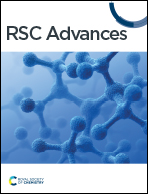Role of the thiosugar ring in the inhibitory activity of salacinol, a potent natural α-glucosidase inhibitor†
Abstract
Herein, ring-cleaved (24) and truncated (25) analogues of an azasugar, 1-deoxynojirimycin (23), exhibited inhibitory activity (Ki = 4–10 μM) equal to that of the parent compound (1, Ki = 14 μM). Based on this structure–activity relationship (SAR), four ring-cleaved (26a–26c and 27c) and three truncated (28a–28c) analogues of salacinol (1), a potent thiosugar-ring-containing α-glucosidase inhibitor, were synthesised. Bioassay results revealed that all the synthetics were inactive, indicating that the 5-membered thiosugar ring of 1 played an essential role in the potent activities of sulfonium-type inhibitors. The present findings are interesting and important in understanding the function of salacinol, considering that the observed inhibitory activity trend was contrary to the SAR observed in aza-compounds (23, 24, and 25) in a previous study, which suggested that the cyclic structure did not contribute to their strong inhibitory activity.



 Please wait while we load your content...
Please wait while we load your content...